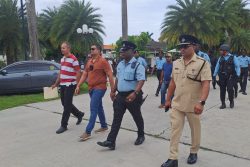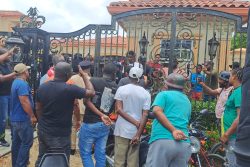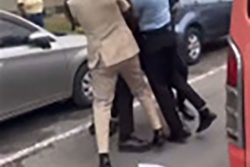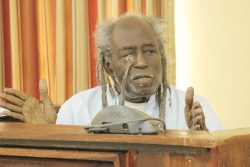The cocaine found by Jamaican authorities on a vessel from Guyana was reportedly packed in five bags stashed in timber that was being transported in a container.
Stabroek News has been reliably informed that the cocaine, which weighed 122.65 kilogrammes, was found in the bags aboard the Vega Azurit. Reports are that the vessel, which left from the John Fernandes Wharf, is said to be one that frequents Guyana as it is one of the “sea freights” that come to Guyana once or twice weekly. The vessel arrived in Guyana on March 11 and left the next day.

The cocaine, said to have a street value of $700 million, was seized on Wednesday morning at Port Bustamante in Kingston, Jamaica by officers from the Customs Department the Jamaica Observer had reported. Stabroek News was told that when customs officers broke the seal to the container, two of the bags were discovered. Upon further checks, the three others bags were found.
According to reports, law enforcement officials in Guyana were not officially informed about the bust and it was pointed out that the Customs Anti-Narcotics Unit (CANU) no longer has responsibility for incoming and outgoing vessels since its officers were removed from wharves some time last year. The checking of vessels is now solely the responsibility of customs officers.
Commissioner General of the Guyana Revenue Authority (GRA) Khurshid Sattaur yesterday told Stabroek News that an investigation has been launched.
He said he is currently checking the records to ascertain how long the ship was in Guyana and when it arrived here. He stressed that the reports out of Jamaica must be verified, while noting that he was informed of the drug bust by CANU authorities, but had expected his Jamaican counterparts to directly make contact with Customs here. “I was taken aback by the report,” he told this newspaper.
Sources indicated to Stabroek News that the name of the shipper and other information would not be difficult to ascertain, since a custom officer would have had to check the container before it was sealed. The officer must have documentation on the work he would have carried out and it was pointed out that the officer should have seen the bags before putting a seal on the container. If the officer sealed the container without checking it, then he or she would have to explain why. A custom officer and a broker would have had to be at the area where the timber was loaded, since the large logs would not have been loaded on at the wharf, Stabroek News understands.
Some had suggested that the scanner system the GRA had installed last year should have easily detected the cocaine but Sattaur said that based on the little information he has, the ship was not scanned before it left Guyana. He said the scanning machine which GRA installed last year is still to be made operational. “Some final touches are being done,” he said.
Sattaur added that GRA received a mandate last April to expand its operations to checking exports leaving the country on ships, and according to him the agency has been working to effectively execute the mandate though it has been a challenge. He views the mandate as a serious responsibility and one that “comes with risks.” However, he said they have been working hard, though struggling owing to the absence of well-trained staff and critical inter-agency cooperation. “I’m not making excuses, but this aspect of law enforcement has been challenging even for CANU… Can you imagine then what the responsibilities mean for us here in Revenue?” Sattaur asked.
He said that in executing the mandate, the GRA is need of great resources. As regards the scanning machine, Sattaur said it would usually take years to install, but they are almost through with the work in just six months. The machine would be operational following some minor work which is currently being carried out. According to Sattaur, the machine would be of tremendous benefit given the work Customs is now required to do.
He said the GRA cannot be blamed for lapses in the system because all the equipment and the expertise to get the job done are not in place. He pointed out that collaboration with other agencies is also very critical, while noting that as it relates to lumber exports the Guyana Forestry Commission has to work along with GRA to get the job done.
Security and safety procedures make for a better working environment, he noted, while adding that several things are still to be put in place to allow GRA to effectively carry out its mandate. Sattaur pointed out that CANU has been assisting GRA and providing much needed technical assistance. “Notwithstanding the critics, we are working at this end, but there are things which need to be put in place to help us do our job.” Sattaur charged that the real focus of the drug bust should not be on the lapse at this end, but on the shady businessman behind the deal. He said those involved in the cocaine trade through exports are out to discredit the GRA and government, in addition to making Guyana look bad. The GRA boss said when he is furnished with all the information he would release the name of the businessman who exported the lumber.
Stabroek News was told that during its investigation, GRA should attempt to ascertain from Jamaica whether fingerprints were taken from the bags and if prints are found and are shared with the GRA then this should be handed over to the police. The police can now run the prints through its database to see if there are any matches.
According to the Jamaica Observer, the Jamaica Customs in a statement said that no arrests had been made and preliminary investigations suggest that the cocaine was destined for Jamaica.
The packages were handed over to the Trans National Crime and Narcotics Division (TNCD) of the Jamaica Constabulary Force (JCF) for further examination and investigation.
In the past cocaine has flowed out of Guyana in a variety of ways. In December 2008 there was a Cdn$40 million drug bust in Ontario, Canada. The drug was stashed in a consignment of pepper sauce and was shipped from Guyana to New Brunswick in Canada. No charges were brought in the case.









